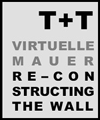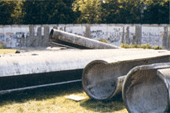
The area we selected for our "virtual stage," stretching from the border crossing at Heinrich-Heine-Strasse over the Engelbecken Park to Bethaniendamm, has a special atmosphere created by the spatial situation together with the events that transpired there. As in a film or theater play, we divided the area into different "scenes" in order to develop the dramaturgie of the interactive artwork. "Scene" in this case means a specific, clearly limited portion of the site which can be used as the "stage set" for one or more events. In each scene we defined the extent and confines of the area, objects in the scene (buildings, vehicles, plants, etc.), the time (year, season, time of day) and characters (border police, civilians, etc.). The emotional atmosphere of each scene is enhanced by placing sound effects and lighting.
For our chosen site we developed dramatic scenarios that enable users to move between different scenes and interactively experience events that transpired here during and after the time of the Wall as dramaturgical consequences of their own actions. The user is confronted with the spatial situation and the special characteristics of the site, and actively involved in the events that occured on this site.
The dramatic techniques of interactive virtual reality enable the users to actively immerse themselves kinesthetically and sensorily in this virtual site in a way that neither still images nor film can match. These techniques include:
- Simulation of a vanished built environment
in a digital 3D model, in which we then embed archival material such
as images, sound and film to "bring it to life."
- Interactivity that enables
users to explore and investigate the site themselves, experiencing
changes in the environment as the results of their own actions.
- Time travel triggered by the actions and movements of the users, fading them backwards or forewards in time, showing them how the site changed during and after the Wall.
| Home |
| Introduction |
| Site |
| > Development |
| Presentation |
| Documentation |
| Artist Team T+T |
| Supporters |
| Berlin Wall Links |
| Events |

[ Research ] [ Dramatic Concept ] [ Hyper-Storyboard ] [ VR Production ]